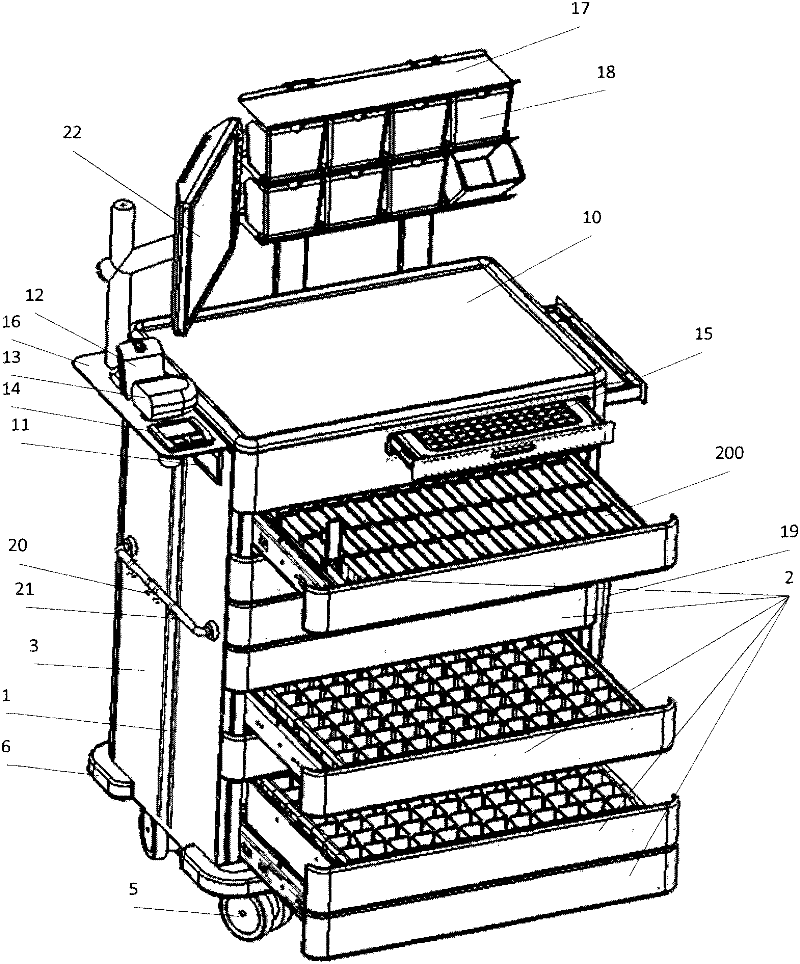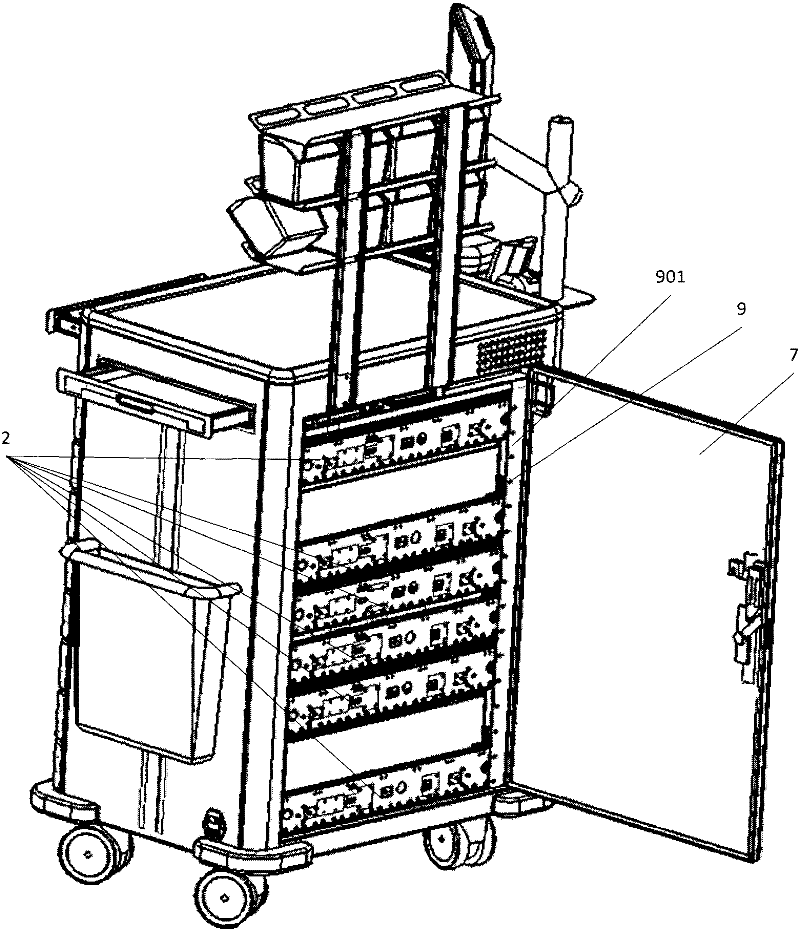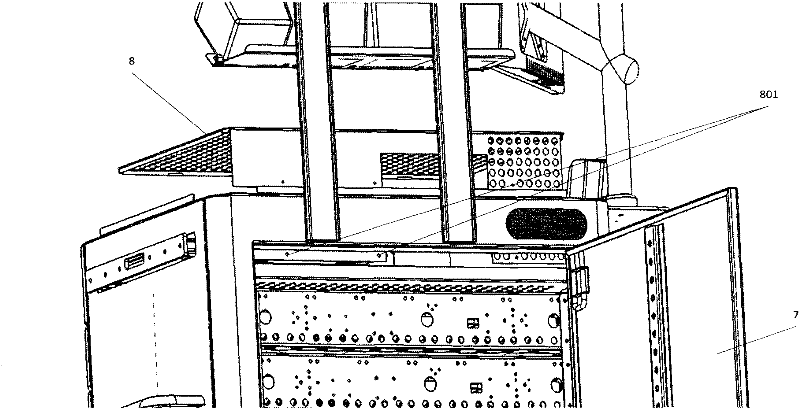Anesthesiologists in the operating room need to quickly get the required drugs and consumables during the operation, but the national regulations on the management of
anesthetic drugs are relatively cumbersome
Therefore, no matter whether the anesthesiologist manages the anesthetics he has received, or takes the medicines from the safe through a special
anesthetic management nurse, it will cause a lot of inconvenience for the doctor to use the medicines. The convenience of taking medicine may violate the country's management regulations
[0003] At present, medicines (including narcotics and non-narcotics) and consumables in operating rooms of domestic hospitals are stored in ordinary medicine cabinets, and are basically registered manually by medicine administrators or
medical staff when used. This management and storage method has the following problems; First, it is difficult to ensure the safety of
drug storage; manual registration has a lot of subjective and human factors, and drugs, especially
narcotic drugs, are prone to accidents such as omissions, mistakes, and loss of drugs, and there are serious security loopholes; second, it is difficult to ensure the safety of
drug use ;Because the anesthesiologist is relatively busy during the operation, it is inevitable that there will be negligence when using it. Sometimes it is too late to register on the use
list when taking the medicine. The use of many medicines and consumables is registered by memory after the operation. Avoid omission or over-counting, resulting in omission or over-charging, and it may cause the
drug to be replenished in time after consumption or lead to errors in tracking the validity period of the drug. Failure to replenish the
drug consumption in time will lead to delays in
surgery. However, errors in drug validity tracking may lead to the possibility of mistakenly using expired drugs or consumables for patients. These impacts on patients are immeasurable; 3.
Drug management is inefficient and consumes a lot of manpower and
material resources; drug management and drug validity tracking Manual operation, some hospitals send
narcotic drugs to doctors, and some hospitals need a special narcotic drug management nurse to manage the drugs, so the use of drugs is completely tracked manually, and it takes a lot of time when the narcotic drug nurses change shifts
Drug statistics lead to low drug
management efficiency and high error rate; 4. It is difficult to adapt to the construction of modern hospitals; the internationally recognized Joint Commission International
Accreditation Standards for Hospital Management has specific requirements. The Chinese hospital
management system must be in line with international standards, and the management of drugs is indispensable.
[0004] In order to solve the problem of drug access and management, the United States currently has several types of drug management cabinets for operating rooms. There are drawers inside, and the sensors on the back of the drawer and the medicine box can respectively
record which drawer and medicine box are open, and send a
signal to the processor. The indicator can display the open drawer or medicine box, but the medicine is contained The drawer of the drawer is manually drawn, which cannot realize the automatic output and positioning of medicines; US Patent US20090187274A1 discloses a medicine
management system, which also adopts the method of manual drawer delivery. The controller can control the opening of each medicine box in the drawer, and there is a special The indicating device shows the position of the specific opened medicine box
[0005] And the drug management cabinets that exist in the prior art all have the following deficiencies: first, the existing drug management cabinets use a very complicated step-by-step pop-up mechanism that controls the ejection of drugs to complete the pick-and-place work of controllable drugs. The principle design of step-by-step pop-up is adopted. When filling medicines, they need to be filled in time order instead of space order. The filling efficiency is low and the management is complicated. Secondly, the existing medicine management cabinets have complicated mechanical structures and high
processing costs. There is a lot of space, the capacity of the whole
machine is limited, and the filling procedure for a single
dose of medicine is more complicated and error-prone; the
software process of the existing technology product is designed according to the American standard, and the operation process is completely unsuitable for China's national conditions and China's drug management and hospitals Management regulations; third, when the external power supply is disconnected and the internal battery power is exhausted, the existing drug management cabinet cannot issue a reset command through the host (controller), so that the drug management cabinet can re-check the
drug storage status; fourth , when the host, drawer, medicine box and other auxiliary equipment of the existing drug management cabinet are being maintained and replaced, different maintenance
doors need to be opened, which increases the difficulty of maintenance, causes complicated mechanical structures, increases the
failure rate and costs Improve, and the increase of the entrance has also improved the difficulty of management, increased the unsafety of repair and maintenance, increased the difficulty of drug monitoring, easy to produce drug loss and missing; the 5th, the medicine box of existing technology storage medicine is directly fixed on The bottom of the drawer and the medicine box need to be disassembled as a whole when replacing and maintaining the medicine box, and the storage space of the drawer is fixed, so the storage space cannot be increased or reduced according to the demand, and it is easy to cause the drawer to be removed in the open state without being reinstalled in time. On installation, it may cause errors in drug management and delays in patients' condition; the 6th, most of the medicine box unlocking of existing drug management cabinet adopts mechanical structure, which is unfavorable for the
electrification control of medicine box, and the
traditional Chinese medicine box cover in the prior art Most of them use a vertical hook mechanism, so that there is an opening on the surface of the medicine box, which is easy to
expose the internal structure of the lock. If the liquid medicine is accidentally dripped in during use, it may cause
corrosion of the internal mechanism of the lock, affecting the opening and closing of the medicine box, and even It will pollute the medicine, affect the
efficacy of the medicine, and easily lead to medical accidents in severe cases
 Login to View More
Login to View More  Login to View More
Login to View More 


